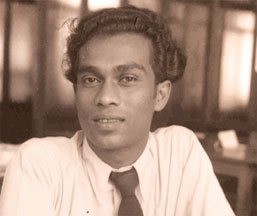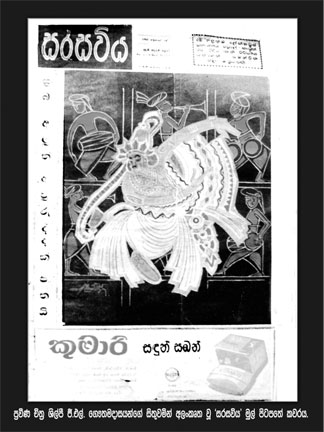Sarasaviya marks golden jubilee
By Kalakeerthi EDWIN ARIYADASA
"Goddess Saraswathie,
who is adorned in radiant white attire, on whose beautiful arm rests the
veena, and whose throne is a white lotus... May you fully remove my
lethargy, sluggishness and ignorance."
Hymn to Goddess
Saraswathie
|

Meemana Prematilake |
It is customary for a co-publication in a chain of publications to be
referred to as a "Sister Publication." This custom proves singularly and
strangely apt, when The Observer talks about Sarasaviya as "Sister
Publication", since Sarasaviya is named after Saraswathie, Goddess of
art and aesthetics - a divine female.
Assuming a particularly important topicality, Sarasaviya currently
celebrates its golden jubilee. In the history of Sri Lankan journalism,
this is a crucial development, since a publication devoted to fine arts
and associated issues, has neither survived nor has continued to
flourish progressively as Sarasaviya has done, in its fifty-year
existence. Today Sarasaviya has established itself in the landscape of
Sri Lankan media with a distinct personality of its own, extending its
influence over a wide-ranging circle of dedicated aficionados.
The inaugural issue of Sarasaviya appeared on April 12, 1963 with the
national New Year festival as its backdrop. The first issue of
Sarasaviya reflected the Sinhala New Year festivities, in many of the
articles it printed. The cover-art by G. L. Gautamadasa, was a
surrealist painting communicating the essential spirit of the Sinhala
New Year season. The debut issue did not, in any way indicate a
specialised thematic loyalty. The articles were not arranged to pivot
round a particular focal concept.
There was no formal manifesto of objectives. In a brief note on the
front page, there was a statement which declared that the new
publication was being brought out to provide "entertainment".
The tabloid format of the new journal represented an innovative step
for that day. The journals of the time were mostly broadsheets
publications.The contents were a potpourri, accommodating articles and
news items on an extensive variety of issues. Most of the writings, for
which Sarasaviya found space in its early years were belletristic in
intent.
If one were to go through some of the early issues of Sarasaviya, one
would be surprised no end, to come upon contributions from such
pre-eminent people such as Prof. Senerath Paranavitana, Munidasa
Cumaratunga, Ven. Welivita Sorata Maha Nayaka Thera and Martin
Wickremasinghe.
 They may not have been direct contributions by those writers. In all
probability many of those would have been excerpted from some of their
previous writings. They may not have been direct contributions by those writers. In all
probability many of those would have been excerpted from some of their
previous writings.
But, there were regulars. R. (Reggie) Pallewela regaled the early
readers of Sarasaviya, with his witty, satirical and quite often
mischievous essays about familiar every-day subjects which his florid
pen elevated to dramatic levels.
Meemana Prematilake was a constant presence. I consider it proper to
mention here that for anyone who is keen to study in-depth, the
evolution of this journal over the past half-century, the collection at
the Government Archives is quite a help.
As the publication gathered momentum, it assumed the stature of the
voice of Sri Lankan cinema. Other forms of fine arts too came within its
purview. But, with the passage of time, Sarasaviya came to be identified
primarily with cinema and its fluctuating fortunes.
All the 'stars' and other people orbiting cinema got attuned
eventually to the idea of considering Sarasaviya their alter ego. When
cinema entrenched itself in Sri Lankan society as mass entertainment
numero uno, proliferating film journals and cinema papers began to
mushroom.
The generality of film publications of that time, could not evolve
beyond rumour-mongering cinema gossip-sheets. Their urge to satisfy the
limited restricted and at times low tastes of their emotionally swayed
fans could not fuel the sustained survival of those film journals. But
Sarasaviya could summon the vigour and the stamina to transcend the
level of gossip-sheets. Several innovative moves ensured its continued
success. The annual Sarasaviya Film Festival proved a highly impactful
trend-setter.
While most other film publications were content with celebrating
ineffective trivia, Sarasaviya went on to initiate a wholesome tradition
of communicating substantial and responsible knowledge relating to
cinema and related issues.In historical hindsight it is essential to
point out that I was requested to contribute a series on outstanding
film directors of the world and classic cinematic products. A whole
series of factors cumulatively ensured the emergence of Sarasaviya into
a cinema publication of substance and prestige.
Over the past 50 years, 12 editors guided Sarasaviya, through a
variety of challenges it had to face. Their collective effort ensured
the unassailable stature of the journal and above all its survival
unscathed in a field of intense competition.
In the early days, Sarasaviya could find itself in somewhat of a
monopolistic position. But in the recent past substantial advances in
the technologies of printing and publishing ushered in an era of radical
changes in the technical aspects of newspaper publishing.
When Sarasaviya made its debut 50 years ago, a tabloid publication
was something of a rarity. But today even dailies erupt with tabloid
inserts - not to say anything about weekend publications which in some
instances, turn out to be collections of inserts of high graphic
glamour.
These eddying and swirling masses of colourful "Inserts" must
undoubtedly prove an unprecedented challenge to the current editor of
Sarasaviya.
The present incumbent Aruna Gunaratne is equal to such ordeals. I am
sure he is a dynamic store of film experience and cinema love and
possesses practical experiences in fiction film and cinema
documentaries.
Objectively reviewed at no time in its past half-a-century of
existence did Sarasaviya have to contend and cope with such potent
impacts as it has to, at present. While felicitating Sarasaviya on its
golden jubilee, it is essential to wish the journal all the creative
vigour to meet the new world of cinema, undaunted. The prayer to its
patron Goddess Saraswathie should guide Sarasaviya enabling it to fully
remove the lethargy, sluggishness and ignorance that still dominate some
areas of cinema and film journalism. |

